by Winding Pathways | Jun 15, 2023 | Nature, Reflections/Profiles, Wonderment
Sitting: it’s a rewarding outdoor activity. How can that be when everyone knows that being outdoors means movement? Hiking, cycling, skiing, canoeing, and swimming all get the heart beating and muscles working.
-
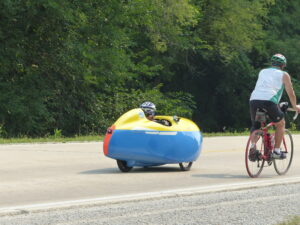
-
You see everything on RAGBRAI
-
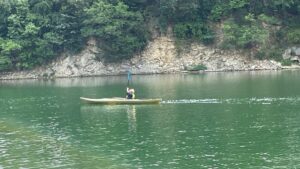
-
Kayaking gets the heart pumping and strengthens the arms
We love all these activities but recently were reminded that sitting quietly is a fascinating and productive way to spend time outdoors. On a gorgeous May morning, we stopped at the road’s end in Iowa’s Brush Creek Canyon Nature Preserve. A narrow informal path lured us past a rock outcropping high above a gurgling brook.
We carried the sling chairs and binoculars that we keep in the car down a narrow informal footpath. Just a hundred yards later we found a level spot with a perfect view downward through trees to the water.
Sit we did. Enmeshed in secluded quiet we sat so still that warblers and vireos flitted among the trees. Even a hummingbird buzzed in front of us. A fly settled on Rich’s pants, explored a bit, and then went on its way.
Active outdoor activities are good for the body and mind, but sometimes sitting is the best way to notice our world and its inhabitants. When we scurry down a trail, wildlife hides or flees. When we sit and become part of the landscape, wildlife ignores the human presence and goes about its business.
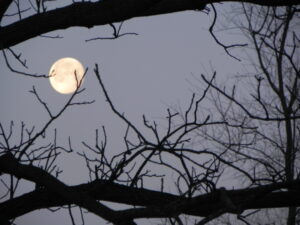
Tree branches help you watch the moon move across the sky.
Here’s our favorite sitting exercise that can be done almost anywhere. As a full moon rises, position a comfortable chair with tree branches or even overhead wires between it and the moon. Sit very still. Using branches or the wire as a reference it’s possible to watch the moon move.
Oh, Brush Creek Canyon. We recommend it as one of Iowa’s wildest natural gems. It’s just north of Arlington in Fayette County. Go outside. Have fun.
-

-
Couple by lake
-
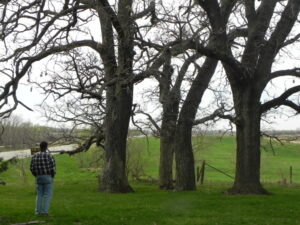
-
Wonderment
-
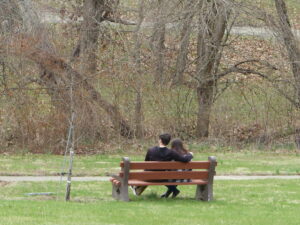
-
Finding peace
by Winding Pathways | May 11, 2023 | Reflections/Profiles

A good friend
The Blue Bridge is gone! Well, it was still there, but when we saw it on April 4, 2023, its back was broken and its span sagged down into Indian Creek. Seeing the prostrate structure and after thousands of crossings on that historic iron bridge, we got a case of the Blues.
From Horse-Drawn Buggies to Modern Vehicles
Spanning Indian Creek near the Indian Creek Nature Center, the blue bridge was built in 1876 for horse-drawn vehicles. It easily made the transition to cars early in the 20th Century but only got its name in 1991 when Linn County painted it bright blue. For decades it was one of several iron bridges in Linn County. Few remain, that we know of, all dating from the late 19th Century.
-

-
Will a new bridge last this long?
-

-
The remaining iron bridge over Indian Creek.
The old span was rugged. We watched it flex when flood water pushed against it. When the water receded, the county was able to quickly reopen the undamaged span.
The old bridge remained functional but, in the eyes of traffic engineers, it had a major flaw. It had but a single lane, meaning when two cars approached from opposite directions one had to wait for the other to cross. It also wasn’t aligned perfectly for speed.
Civility vs. Speed
“I loved the lesson in civility the Blue Bridge provided. I’ve crossed it every day for years and when I wait for another car to pass that driver waves and smiles in thanks. The bridge may have lacked efficiency but it fostered courtesy,” said Jean Perkins, a local resident.
Speed counts these days, and the County is building a modern double-lane concrete bridge with a straight alignment. It is expected to open this fall, allowing faster-moving cars to pass each other as they cross Indian Creek with nary a nod to acknowledge the other.
What’s Lost
Here’s what society lost with the passing of the Blue Bridge:
- History.
- Courtesy, smiles, and polite waves from waiting and passing motorists.
- While waiting for another car to transit, a motorist had a few seconds to enjoy the balm of Indian Creek, nearby trees, and trail users passing under the approach.
What’s Gained
- About 15 seconds of time gained by not having to wait and a faster speed limit.
- Heavy vehicles can transit it.
Goodbye to History and Beauty
The new bridge is a concrete structure that will look like dozens of similar bridges. The Blue Bridge lasted 147 years. It’s hard to imagine its replacement having a useful life that long.
We’ve traded the history and beauty of the old bridge, along with courtesy, for speed and efficiency. Perhaps we’ve lost more than we’ve gained. That gives us the Blue Bridge Blues.
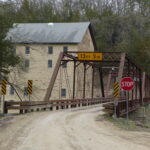
Bridge at Motor Mill in NE Iowa.
Post Script: Recently we visited Motor Mill in NE Iowa and found a lovely steel bridge that had been rebuilt to modern standards and which retained the old feel.
by Marion Patterson | Jan 26, 2023 | Reflections/Profiles
Several people have sourly said, “Good riddance to 2022.” This day, swaddled in dense fog that muffles sound and limits sight, I’m reflecting on 2022. As we noted in the Gratitude jar on the shelf, the year before, “Good things DID happen (in 2021).” Below are some generalizations of Gratitudes gleaned from the scraps of notes stuffed in the pickle jar on the counter.
Any number of times I noted “sublime day.” Perhaps the air and sun were in perfect balance. We completed errands smoothly. Or our energy simply flowed easily. Sitting on the deck with the bunny stretched out we were at ease.
Our few camping experiences gave respite to the “busyness” of the days. Quiet. No cell phones. Close to nature. Tall tulips in PA on our way to Falling Water. Weird geological formations in Nebraska’s Toadstool. The hoot of an owl in Iowa’s Yellow River.
Getaways and Friends
Other getaways offered contrasts. Floating the Niobrara River on a calm, mild spring day followed by driving through a blinding snowstorm the next day. The renovated, upscale Belvoir Winery & Inn in Missouri is surrounded by decrepit buildings of the long-abandoned Odd Fellows rest home. Reliving a dusty Kansas cattle drive in old Abilene at 109 degrees and stepping into the modern coolness of the Eisenhower and Truman Presidential Museums.
-
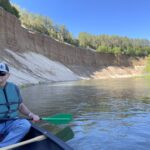
-
A balmy day followed by snow!
-

-
The former Odd Fellows Rest Home.
-
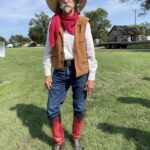
-
The cowboy on duty.
Interactions with friends and family. Reflecting on neighbor interactions, to book clubs, to yoga, to Firepit Friday gatherings, to coffee in the cabin and coffee shops, to the Veriditas and The Labyrinth Society colleagues. And, the bunny, Oreo, who was a wonderful Pandemic friend. She is still with us in memories and evidence of chewed cords and door frames. She was a character and a good friend.
Family connections over the miles on Facetime, ZOOM, in person, calls, photos, emails, and letters/cards. A way to be engaged with each other.
Engaging activities keep us active, healthy, and connected: Hoover Hatchery monthly blogs and Facebook Lives, writing for magazines and The Gazette, our Winding Pathways blogs, guiding labyrinth walks in person and virtually with Veriditas, walking and bicycling – on trails and (walking) inside as needed, playtime and projects with neighbor kids, monitoring students’ online course progress through Kirkwood Community College, watching Great Courses, helping with Faith Formation at church. And, appreciating the creative spirit and functionality of the Director of Faith Formation. The centering and balancing work with cancer patients and staff at the Nassif Community Cancer Center.
Reflecting on Deferred Gratification
Reflecting on the benefits of “deferred gratification” by having been careful with resources over the years and repairing/nurturing the land. Thanking the derecho trees for providing heat in the winter’s woodstove. Planting, tending and harvesting garden produce. Appreciating the chickens and giving them treats and a warm, safe place to live.
Thinking ahead: checking the air conditioner in April before the hot weather. Similarly, servicing the furnace and hot water heater in August. Maintaining the vehicles for optimal mileage and comfort – Rotate tires, change oil, fill windshield cleaner, change the blades, wash the outside, and detail the inside of the vehicles. Knowing steps to be prepared for outages, to stay home in inclement weather, and simply be at ease with what is.
Supporting educational to non-profit organizations locally and across the country.
Attitude
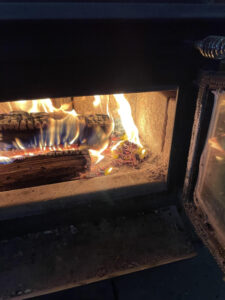
Releasing memories to the ethers.
Although we can be sour about the downs of 2022, and there were a number of them, we can also appreciate the positives. That slight shift in reflecting helps ease the path for ourselves and others as we journey into 2023. Now, with gratitude for reflecting on 2022, I respectfully add these gratitudes to the woodstove that keeps us warm. The memory of these reflections keeps my heart warm.
by Winding Pathways | Dec 29, 2022 | Reflections/Profiles
Henry is still a teacher.
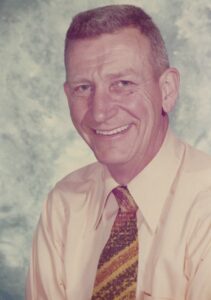
Henry taught middle schoolers more than shop.
Our feature today is different. It’s about an amazing teacher. Winding Pathways blogs are normally about yards, backyard chickens, labyrinths, and occasional touches of home care and energy efficiency. It’s about a 99-year-old who retired from his formal education career in 1996. Yet he continues to be a teacher for the fortunate people he encounters.
Henry Patterson, Rich’s father, was a teacher in the Florham Park, NJ, public schools for many years before retiring to his home in nearby Denville to spend senior years with his wife, Claire. Age caught up with them and they moved to a senior community, The Oaks of Denville, in 2018. Claire died the following year. Despite the grief, Henry has nurtured his sunny disposition as he has approached being a centurion.
“Look On the Sunny Side of Life”
He’s adored by the staff and residents at The Oaks as well as his family and friends in Denville. Everyone’s happy to see him, chat for a while, and enjoy his smile. Many help with daily functions that increasingly challenge a man who has lost most of his vision and some mobility. Regularly, former “shop” students dropped by the house and still visit at The Oaks.
As many people age, they become bitter, frustrated, and angry. Think mosquito repellent. We put it on to keep the pesky bugs at bay. It works but isn’t confined to chemicals in a jar. Abrasive behavior repels people trying to render kindness and assistance.
-

-
Based on his scouting experience, Henry taught other sailors knots.
-
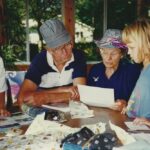
-
Henry’s father was a railroad engineer…
-
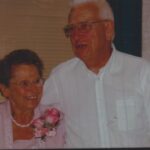
-
Claire and Henry lived on the Lake.
-
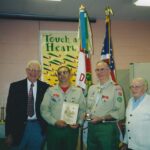
-
Henry has been a scout most of his life.
Crafting Beyond “Shop”
Henry has refined the opposite model. He’s appreciative, thankful, understanding, kind, and always pleasant to everyone at The Oaks. From the high school students who work in food service to medical professionals who help him, and fellow residents Henry has a smile and a joke. His sense of humor shines so warmly that it takes him a while to walk down the corridor. This is not because 99 years of age slows his pace but because everyone he encounters he pauses for a kind word and usually caps the brief visit with a joke.
Henry taught thousands of middle school students how to craft amazing creations in his school industrial arts shop, but education didn’t stop on retirement day. He continues to teach everyone in his orbit that a warm personality and expressions of thanks and appreciation are rewarding and life-enhancing.
-

-
Henry attends and walks or rides in every Memorial Day parade that he can.
-

-
Residents gather for meals and conversation.
-
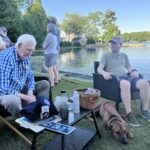
-
Lakefront
-
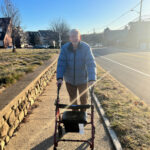
-
Henry walks daily as weather allows.
by Winding Pathways | Dec 1, 2022 | Reflections/Profiles, Wonderment

People enjoyed the carousel rides at Fairfield, Iowa.
We invite you to share a serendipity you have experienced. A recent overnight to Fairfield, Iowa, delighted us with unexpected bliss, a sense of connection, and enchantment. On recalling other times when we found ourselves in wonderous situations and with engaging people we decided to ask readers to share their times of serendipity. When all aligned and you were left feeling happy and blessed. So, we would like to hear from you. Send a short remembrance and photo if you have one to us by December 10, 2022. Later we will combine your remembrances and ours, and post as a blog on Serendipities.
by Winding Pathways | Sep 1, 2022 | Nature, Reflections/Profiles
Remembering Sockeye Work
Rich Patterson and Kammi Matson of the Popsie Fish Company
In early July we enjoyed an amazing natural phenomenon at the Campbell Creek Science Center in Anchorage, AK. We walked with our daughter to the small stream that gives the Center its name and spotted splotches of red in quieter stretches of the Creek.
Sockeye Salmon were resting there after wriggling up rushing riffles and rapids. Seeing the fish brought back Rich’s 50-year memory of the scientific work he did on this fish species a half-century before.
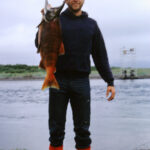
Red salmon spawning color and kype.
In 1972 he was stationed at the Ugashik Tower on a remote river about 250 miles southwest of Anchorage. The task of his crew was to count Red Salmon migrating upstream and to report numbers to the head biologist in the town of King Salmon. Counting was done by perching in a riverbank tower made of aluminum scaffolding, peering into the water, and counting fish swimming by.
At first, work was boring. No salmon were in the river. Then a miraculous change happened. Rich glanced downstream to view a river of red plowing upstream against the strong current. For two weeks, night and day, salmon passed the tower on their way upstream.
Salmon Species
Five species of salmon are native to North America while a sixth only lives in Asia. All are anadromous, meaning that they hatch in freshwater but spend much of their life in the sea before returning to their natal stream to spawn. While other Pacific salmon like the King, Chum, Silver, and Pink, feed on chunky animals, mostly small fish, Sockeyes, or Reds as they are called in Alaska, prefer different food.
What is Unique About Sockeye?
Most Sockeyes spawn in the gravel of small tributary streams that feed Alaska’s vast lakes of Iliamna, Becherof, Naknek, Ugashik, and others. Tiny fish descend the stream and usually spend two years swimming around the lake straining plankton from the water until they reach roughly sardine size. Then, on a few April nights, millions of salmon, called smolts, descend the big rivers to Bristol Bay. For the next two years, they circle the vast Pacific once or twice, eating zooplankton, small fish, and squid. They swim with their mouths open so their filter-like gills can strain tiny animals from the water.
When a smolt enters the Bay at two years old it weighs under an ounce. Think of that! When it returns from the nutrient-rich ocean two years later it weighs between six and 12 pounds!
For most of their lives, Red Salmon are not red. They’re silvery. When entering freshwater their skin quickly turns bright red and their heads green. Males grow a formidable-looking hooked snout. On their journey, they cross a lake and mate in small feeder streams beyond.
Sockeye are probably the most delicious of all fish, eagerly caught by commercial fishers based in Bristol Bay to be canned, flash frozen, or shipped fresh to consumers around the world. The best-tasting fish are caught before their skin reddens, but their rich flesh is always bright red.
How Do We Avoid Overfishing?
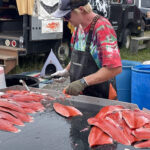
Processing salmon
Most people realize that overfishing devastated the once vast schools of Atlantic Cod off New England and Canada. So, how can science work with commercial and sport fishers to ensure that Alaska’s red salmon remain abundant while providing a generous harvest of delicious food?
In theory, it’s simple. Let enough fish “escape” nets and hooks to spawn a new generation and add the fertility of their dead bodies into the water to nourish the plankton that feed youthful salmon. In practice, it’s more complex.
Biologists rely on electronics and human eyes to make sure enough salmon ascend rivers to keep numbers high and sustainable. Fishers are allowed to catch the surplus. It works. Vast numbers of Red Salmon, perhaps as many as 50 million, were caught and shipped in 2022 while plenty of escapees spawned. Anyone can enjoy eating a salmon filet knowing it’s not sending Red Salmon the way of the Atlantic Cod.
How Can You Get the BEST Sockeye in Iowa?
We love eating Sockeye Salmon and prefer grilling it over a gentle wood fire. The trouble is we live in Iowa. No salmon here, but a few years ago we were able to buy Egegik River fish from a local meat market that has since gone out of business. We now order from the Popsie Fish Company, which sends ten pounds of frozen filets to our home.
Popsie caught these fish near Alaska’s second largest lake, Becharof. That’s close to where Rich worked years ago at Ugashik. The Egegik River flows from Lake Becharof to Bristol Bay.
To order fish go to Popsie’s website. To see Sockeye in their red-colored glory without the need to fly to the distant Alaska Peninsula visit the Campbell Creek Science Center in mid-July in Anchorage and walk along a pleasant trail to the Creek. Its salmon run is modest in size but easily accessed.


























